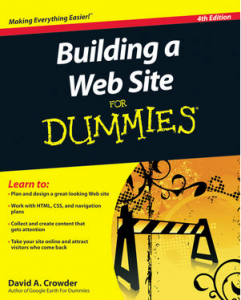 Building A Web Site For Dummies
Building A Web Site For Dummies
by David A. Crowder
Wiley Publishing, Inc.
www.wiley.com
ISBN: 978-0-470-56093-8
$24.99 US / $29.99 CN / £17.99 UK
342 pages
Many people are familiar with HTML and CSS, and think that’s all you need to put together to make a pleasing web site. Others feel that by using an application such as RapidWeaver or Adobe Dreamweaver, most of the work is done for them. Sadly for these people, that’s not the case.
David A. Crowder’s latest book, Building A Web Site For Dummies, takes the reader through the steps involved to, well, build a web site. The book is divided into five sections:
- Building Your First Web Site
- Building Better Web Pages
- Adding Frills and Fancy Stuff
- Making Money
- The Part of Tens
The first section assumes you are at least familiar with HTML. Not necessarily an expert, but have a basic understanding of HTML code. Crowder then moves on to advanced HTML, including tables and frames. Finally, he tackles the topic of choosing a domain name and host for your newly created web site.
The next two sections dive a little deeper into HTML, CSS, forms, images, JavaScript, blogs, and multi-media. At this point, having a background, or at least another reference book, about these topics will be very handy. This is a book about building a web site, not about creating JavaScript or editing images, so Crowder’s discussion just covers the basics. Section four goes into details about publicizing and monetizing your web site. Crowder does a nice job explaining what keywords are, how they’re used, and how to submit your site to search engines. He then explores the ins and outs of Internet commerce and online payment methods.
Of course, as with all Dummies-series books, Building A Web Site For Dummies concludes with the infamous Part of Tens.
The Part of Tens, for the uninitiated, are a few chapters at the end of each Dummies-series book that list ten items, web sites, frequently asked questions, or bits of information for readers to further explore. In Building A Web Site For Dummies, Crowder introduces readers to “Ten Great Web Sites to Get Advice,” “Ten Fabulous Tools for E-Commerce,” and “Ten More Great Add-Ins.”
Each chapter ends with online resources pertaining to the information discussed in that chapter, in addition to the resources listed within the chapter. A very nice touch. If that’s not enough, Crowder shares mini tutorials on adding a blog to your web site, creating a logo, adding Google Site Search, and a few others.
The one big issue I have with this book is that many tutorials are done with CoffeeCup HTML Editor. I have nothing against CoffeeCup specifically, but I’m sure the number of people using a different web editor is greater than the number of people using CoffeeCup. Plus, Coffee Cup is a Windows-only editor, so that information is totally useless to Mac users who may want to consider using it. I’m a big believer in knowing at least basic HTML and CSS when using a web editor, even if it’s template-based. It’s hard to find coding errors when you don’t know what you’re looking for. Unless a book is about a specific web editor, tutorials, in my opinion, should be done in an application like TextEdit or NotePad so the principles can be applied to both Mac and Windows users.
Overall, Building A Web Site For Dummies is a handy book to have if you’re considering making your own web site. I would not rely on it as your only reference, however. Be sure to have a coding book nearby that can answer questions that Building A Web Site For Dummies cannot.
MyMac.com rating: 7 out of 10

Leave a Reply
You must be logged in to post a comment.